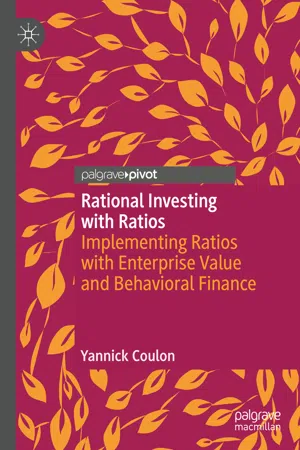Business
Leverage Ratios
Leverage ratios measure the extent to which a company relies on debt to finance its operations and growth. They provide insight into the company's financial risk and ability to meet its debt obligations. Common leverage ratios include the debt-to-equity ratio, debt ratio, and interest coverage ratio, which are used by investors and creditors to assess a company's financial health and stability.
Written by Perlego with AI-assistance
Related key terms
12 Key excerpts on "Leverage Ratios"
- Michael Chibili(Author)
- 2019(Publication Date)
- Routledge(Publisher)
Solvency ratios indicate the ability of a company to meet its obligations when they are due, including the principal and interest on their long term debts. There are principally 2 basic sources of funds to finance a company which are; funds received from the owners, and financing received through contracting debts with third parties, which may include finance houses, suppliers, employees and the state. Other terms for solvency ratios are leverage or gearing ratios. The owners may provide substantially all of the funds that a company needs or there will be a combination of owner participation and financing from third parties. The risk of insolvency of organization depends on the amount of funding brought in by the owners and by the other parties. Leverage refers to the amount of long term debt that is used to finance the assets of a company compared to the amounts of owners’ equity. A company with significantly more debt than equity is considered to be highly leveraged.Solvency ratios as a category are made up of ratios that can be split into 2 subgroups;• those ratios which are based on the balance sheet (solvency ratio, debt to equity ratio, long term debt to total capitalization ratio);• those based on the income statement (the number of times interest earned ratio, the fixed charge coverage ratio, and the debt service coverage ratio) as well as the operating cash flows to total liabilities ratio which is based on both the balance sheet and the SCF.From the general perspective of management and with the expanded use of leases, management contracts, joint ventures, and other financing techniques, Leverage Ratios must be carefully evaluated before conclusions are drawn. Generally, if the interests on the borrowed funds are less than the earnings which can be generated from using these funds then it will be advantageous to make use of leverage.The solvency ratio, as a specific ratio, indicates the organization’s ability to take care of its long term obligations. The solvency ratio is calculated by using the following formula:Solvency ratio
Total assets Total liabilitiesThe solvency ratio is normally expressed as coverage of so many times, for example 2.34 times or 2.34:1. This ratio is a measure of the solvency of a company at a given point time, but it ignores the effects of future inflows of funds from the operations of the organization. The greater the leverage used by the organization the lower will be the solvency ratio. Creditors generally prefer a high solvency ratio as it gives them the assurance of having something paid back in the event of the liquidation and disposal of the organization’s assets. On the contrary, owners would prefer lower solvency ratios because this will help them in maximising their returns on investment.- eBook - ePub
Excel for Finance and Accounting
Learn how to optimize Excel formulas and functions for financial analysis (English Edition)
- Suraj Kumar Lohani(Author)
- 2023(Publication Date)
- BPB Publications(Publisher)
Chapter 2, Preparing Financial Statements Smartly . They are very helpful for the investors, lenders/banks, or creditors to understand a company’s financial status.There are six types of financial ratios:- Liquidity Ratios
- Solvency Ratios
- Profitability Ratios
- Return on Sales Ratios (Profitability Ratios)
- Return on Investment Ratios
- Turnover Ratios
- Valuation Ratios
- Growth Ratios
Importance of Financial Ratios
The importance of financial ratios can be explained as follows:- Analyzing a company’s financial ratios can provide a shareholder with a better understanding of its profitability, liquidity and so on.
- Financial ratios are used by investors to understand the financial health of a business. It is applicable for both public and private companies.
- A single ratio cannot be examined; a set of ratios are needed, so the knowledge of various indicators is a must, and it can be used as KPIs in budgeting, costing, financial modeling, CMA loan data and so on.
Liquidity Ratios
They are calculated to understand the company’s capability to pay short-term obligations. Liquidity refers to liquidating all current assets to meet all obligations or debt of all current liabilities. Liquidity ratios are also known as working capital ratios because they define the current (immediate) scenario of the company without raising external capital. It is compared with peer competitors or with the company’s own performance in the previous years. The comparison cannot happen across industries, for example, a coal manufacturing company cannot be compared with a coal trading company. - eBook - ePub
Rational Investing with Ratios
Implementing Ratios with Enterprise Value and Behavioral Finance
- Yannick Coulon(Author)
- 2019(Publication Date)
- Palgrave Pivot(Publisher)
© The Author(s) 2020 Y. Coulon Rational Investing with Ratios https://doi.org/10.1007/978-3-030-34265-4_4Begin Abstract4. Debt Ratios
Yannick Coulon1(1) Brest Business School, Brittany, FranceYannick CoulonAbstract
Debt, as much as an opportunity as a threat, must be monitored. First, financial leverage and its effects on income, both positive and negative, must be defined.The core of the chapter focuses on debt ratios by comparing the relative size of debt to equity on the balance sheet, or by comparing the relative size of debt or its repayment to the cash flows generated by the company.Two case studies illustrate the limits of the classic debt to equity approach based on book value. Excessive financial leverage is then addressed via the instability theory of the late professor Hyman P. Minsky. Finally, a sample of large players in three sectors is displayed to show that debt levels are sector related. Key takeaways on debt ratios and their limitations conclude the chapter.Keywords Financial leverage Debt to equity ratios Debt coverage ratiosEnd AbstractFinancial instability hypothesis of professor Hyman P. MinskyCreditworthiness4.1 Introduction on Indebtedness
Debt, as much as an opportunity as a threat, must be monitored. The company financing mix between debt and equity must be optimal (i.e., trade-off between the low after-tax cost of repayable loans versus the high cost of stable and permanent equity).There is an inherent conflict of interest between lenders and equity holders. Additional borrowing enhances shareholder profitability, but it represents a risk for lenders as they become more exposed without benefiting from the additional return. Therefore, there is a limit beyond which lenders will not further finance the expansion of a company. - eBook - ePub
A Pragmatist's Guide to Leveraged Finance
Credit Analysis for Below-Investment-Grade Bonds and Loans
- Robert S. Kricheff(Author)
- 2021(Publication Date)
- Harriman House(Publisher)
be examined.Another way to use the leverage ratio is that it can be run at various levels of seniority in the debt structure. If a company had €1 billion in secured bank debt, €500 million in senior subordinated debt, and €250 million of adjusted EBITDA, it could be said that its bank leverage was 4× (1 billion/250 million) and its total leverage was 6× (1.5 billion/250 million). The size of the increase in leverage between the two tranches has a big impact on how the two pieces of debt might trade relative to each other. If the difference in the leverage ratio between the bonds and loans were 1× rather than 2×, the yields on the secured and unsecured debt should be closer than if the differential were 2×.A Pragmatic Point on ValuationsThe preceding section highlighted EBITDA multiples for valuing a company. Using EBITDA multiples is a quick and fairly efficient way to derive enterprise values. Ratios such as EV/EBITDA are frequently used as a valuation measure. Another common multiple used in the equity market is the price/earnings ratio. Ultimately, these methods are shorthand versions for discounted cash flow (DCF) analysis, which is the best way to measure cash-flow-producing assets. The valuation of stock, theoretically, should represent the aggregate of what the universe of investors thinks is the right DCF value for a company.This is true even for assets that are not producing cash flow. As an example, think of a company that has unused real estate. Buyers, consciously or unconsciously, will factor in what all the costs will be to develop the land and net that against the cash flow they believe they can get for the developed property. They may think of this in a value-per-square-foot format, but ultimately, that value per square foot is a proxy for how much cash flow can be generated from the asset. - eBook - ePub
- Steven Cohan(Author)
- 2018(Publication Date)
- Routledge(Publisher)
Ratios provide us with a perspective of relationships between two entities. They are found by dividing the magnitude of one entity into the other. We hear and read about ratios every day, particularly in sports. A college basketball point guard who averages twenty shots per game and makes five baskets has a ratio of baskets/attempted shots of 5/20 or 25%. This information assesses the player’s shooting ability, which at 25% would not raise any eyebrows or attract any NBA offers.Financial ratios also provide an index of performance. They indicate how well a business is financially managed. These ratios are calculated from information extrapolated from financial statements. Business ratios are categorized into liquidity ratios, debt ratios, activity ratios, productivity ratios, and profitability ratios.Liquidity Ratios
The liquidity status of a company indicates its ability to pay short-term debts with current assets. Liquidity refers to the state of being liquid in terms of cash and assets that can be readily converted into cash. Personal liquidity status would include cash in savings and checking accounts, certificates of deposit, and stocks.Liquidity ratios measure the current assets of a company against its current liabilities. Current assets are those that can be converted into cash within a twelve-month period. These assets include inventory, accounts receivable, cash, and securities, such as certificates of deposit, money market funds, and stocks. Current liabilities refer to debts that will be paid within a twelve-month period. These liabilities include loan payments, vendor invoices, state and federal taxes, payroll, insurance premiums, leases, and rent.Three primary ratios measure a company’s ability to meet its current financial obligations with its current assets. These ratios are the current ratio, quick ratio, and cash to current liabilities.Current ratio
The amount of current assets and current liabilities is obtained from the company’s balance sheet. Current ratio - eBook - ePub
The Art of Company Valuation and Financial Statement Analysis
A Value Investor's Guide with Real-life Case Studies
- Nicolas Schmidlin(Author)
- 2014(Publication Date)
- Wiley(Publisher)
Chapter 3
Ratios for Financial Stability
Change alone is eternal, perpetual, immortal. Arthur SchopenhauerA long-term investment has to fulfil two fundamental criteria. First, it should yield an appropriate return on the invested capital. Indicators for this were introduced in Chapter 2. Second, a business can operate successfully in the long run only if it has a solid capital structure and sufficient cash flow. The following chapter provides ratios to validate and quantify the financial stability of a company. Although profitability ratios were introduced first, the importance of financial stability can hardly be overestimated. Particularly in the business world, Murphy’s Law is more applicable than ever: anything that can go wrong, will go wrong.3.1 EQUITY RATIO
Equity ratio indicates which proportion of the total assets is funded by shareholders’ equity.Companies with high equity ratios are usually considered to be conservatively financed. The higher the equity ratio, the lower the company’s use of leverage. In contrast to shareholders’ equity, debt has the advantage of being tax-deductible, as interest expenses are usually tax-deductible, lowering the company’s tax burden. Moreover, debt is a cheaper source of funding than equity, because in the case of insolvency, creditors’ claims rank senior to equity and hence will be paid back first. Creditors are therefore exposed to lower risk and will consequently demand a lower compensation in return. Shareholders, meanwhile, will be considered only after creditors have been fully paid out. Since debt is cheaper than equity, a certain proportion of borrowed capital can be found in any business to lower the total cost of capital. In addition to that, when funding its working capital, a minimum amount of debt is sensible. Inventory, for instance, is usually funded by supplier credits or revolving credit lines. However, increasing levels of debt raises the risks for an enterprise, as the interest burden grows and the debt has to be paid back or refinanced at some point in time. Especially in a downturn, the fixed nature of interest payments can become problematic for businesses that operate in cyclical industries or have low profit margins in general. Paracelsus’s theory also applies to the use of debt: the dose makes the poison. - eBook - ePub
Financial Intelligence for IT Professionals
The Story of the Numbers
- Julie Bonner(Author)
- 2021(Publication Date)
- CRC Press(Publisher)
Part Five The Power of Financial RatiosDOI: 10.1201/9781003110613-5Financial ratios can give you quite a bit of insight into a company.1 The key is to understand what you are looking for and how to interpret the numbers. In this section, several different ratios will be explored using the two companies as a source of information to illustrate the power of these ratios. This knowledge serves two purposes. For one purpose, you can see how this information is gathered and from what sources, and the other purpose is to see how these ratios are applied.In addition to this, you can then use this as a model for analyzing a company you work for, or you can use this as a model for analysis of a company you are considering purchasing or use this as a model to determine if you want to invest in a specific company. You can also use this as a model by which you study a company that you invest in financially. These ratios can be used in all of these scenarios to help paint a picture of financial performance. Plus, if you look at this data every month, every quarter, or every year, you will gain insight into financial performance, and you will be training your financial intelligence to where the hyperbole of any executive will not sway you. Training your gut to be aware of the information that the results of these ratios give you can prove invaluable.Within this section of the book, you will be learning about ratios that fall into four distinct categories. These categories are profitability, solvency, liquidity, and activity ratios.2The profitability ratios look at a company’s ability to consistently generate or grow its gross margins and net profit margins. You are aware that profit is an estimate, but you know that a business’s operations generate and use cash. Thus, even though you could be looking at estimated numbers and know why they are estimated, you can still see how easily cash is being generated and used in the company. - eBook - ePub
- Stephen L. Nelson, Christian Block(Authors)
- 2023(Publication Date)
- For Dummies(Publisher)
Industries commonly prepare reports that summarize financial ratio information for other firms in the industry. Early in my career, I was the controller of an electronics manufacturing firm. Our industry group, the American Electronics Association, prepared a financial ratio survey. With this financial ratio survey, I was able to easily compare the financial ratios of the firm I worked at with the financial ratios of other firms. Currently, as a CPA, I find it very useful that the Texas Society of CPAs and American Institute of Certified Public Accountants prepare an annual financial study that shows financial ratios for CPA firms around the United States. You probably also operate in an industry that has a professional association. Keep your eyes and ears open to the possibility that this group or association prepares and distributes reports that include financial ratios. Such reports can be useful tools for you as you manage your firm.Note: When you compare your firm with other firms by using financial ratios, you compare it with firms of a similar size. It usually doesn’t make sense to compare, for example, a million-dollar business with a billion-dollar business.Some of the QuickBooks financial statements provide simple financial ratios automatically. You can add the gross margin percentage (and other percentage measures) to the standard income statement and to the standard balance sheet, for example.Looking at Liquidity Ratios
Liquidity ratios measure how easily and comfortably a firm can pay its immediate financial obligations and exploit immediate short-term financial opportunities. Everything else being equal, the firm that’s sitting on a large hoard of cash can more easily pay its bills and take advantage of great opportunities that pop up. (If a competitor gets into trouble and wants to sell valuable assets at fire-sale prices, for example, a very liquid firm with great gobs of cash can more easily exploit such an opportunity.)Current ratio
The current ratio liquidity - eBook - ePub
- Bijan Vasigh, Javad Gorjidooz(Authors)
- 2016(Publication Date)
- Routledge(Publisher)
An important application of financial ratios is in the process of credit rating a particular organization. Credit ratings are vital in an industry like aviation which is heavily dependent on leasing and external sources of financing. Ratio analysis can be applied to an aircraft, a runway, an employee, a passenger, a market, a company, or even an entire industry. The ratios can be broadly classified under seven different types which will be discussed in detail in this chapter.- ◆ Liquidity Ratios
- ○ Current Ratio (CR)
- ○ Quick Ratio (QR)
- ◆ Asset Management Ratios
- ○ Accounts Receivable Turnover Ratio (ART)
- ○ Average Collection Period (ACP)
- ○ Inventory Turnover (ITO)
- ○ Fixed Asset Turnover Ratio (FAT)
- ○ Total Asset Turnover Ratio (TAT)
- ◆ Financial Management Ratios
- ○ Debt Ratio (D/A)
- ○ Debt to Equity Ratio (D/E)
- ○ Times Interest Earned Ratio (TIE)
- ◆ Profitability Ratios
- ○ Gross Profit Margin (GPM)
- ○ Operating Profit Margin (OPM)
- ○ Net Profit Margin (NPM)
- ○ Return on Total Assets (ROA)
- ○ Return on Equity (ROE)
- ◆ Dividend Ratios
- ○ Dividend Payout Ratio (DPR)
- ○ Dividend Yield
- ◆ Market Value Ratios
- ○ Market to Book Ratio
- ○ Price–Earnings Ratio (P/E Ratio)
- ◆ DuPont System Ratios
- ○ Return on Assets (ROA)
- ○ Return on Equity (ROE)
- ◆ Window Dressing
- ◆ Altman Insolvency Index
- ◆ Key Financial Ratios for the Airline Industry
- ○ Available Seat Mile (ASM)
- ○ Revenue Passenger Mile (RPM)
- ○ Cost per Available Seat Mile (CASM)
- ○ Revenue per Available Seat Mile (RASM)
- ○ Revenue per Revenue Passenger Mile (RRPM) or Passenger Yield
- ○ Average Stage Length (ASL)
- ○ CASM (Stage Length Adjusted)
- ○ Average Daily Block Hour Utilization
- ○ Load Factor (LF)
- ○ Break-even Load Factor (LFb - e )
- ◆ Summary
- ◆ Discussion Questions and Problems
Liquidity Ratios
Liquidity ratios are used to determine a firm’s ability to meet its short-term (usually, within the next reporting period) financial obligations. Investors often consider liquidity ratios when performing a fundamental analysis of a company. Because a company that is consistently facing difficulty in meeting its short-term debt is at a higher risk of bankruptcy, liquidity ratios are a decent measure of whether a company will be able to securely continue as a going concern. - No longer available |Learn more
- Stephen L. Nelson(Author)
- 2020(Publication Date)
- For Dummies(Publisher)
Industries commonly prepare reports that summarize financial ratio information for other firms in the industry. Early in my career, I was the controller of an electronics manufacturing firm. Our industry group, the American Electronics Association, prepared a financial ratio survey. With this financial ratio survey, I was able to easily compare the financial ratios of the firm I worked at with the financial ratios of other firms. Currently, as a CPA, I find it very useful that the Texas Society of CPAs and American Institute of Certified Public Accountants prepare an annual financial study that shows financial ratios for CPA firms around the United States. You probably also operate in an industry that has a professional association. Keep your eyes and ears open to the possibility that this group or association prepares and distributes reports that include financial ratios. Such reports can be useful tools for you as you manage your firm.Note:When you compare your firm with other firms by using financial ratios, you compare it with firms of a similar size. It usually doesn’t make sense to compare, for example, a million-dollar business with a billion-dollar business.Some of the QuickBooks financial statements provide simple financial ratios automatically. You can add the gross margin percentage (and other percentage measures) to the standard income statement and to the standard balance sheet, for example.Liquidity Ratios
Liquidity ratios measure how easily and comfortably a firm can pay its immediate financial obligations and exploit immediate short-term financial opportunities. Everything else being equal, the firm that’s sitting on a large hoard of cash can more easily pay its bills and can take advantage of great opportunities that pop up. (If a competitor gets into trouble and wants to sell valuable assets at fire-sale prices, for example, a very liquid firm with great gobs of cash can more easily exploit such an opportunity.)Current ratio
The current ratio liquidity - Edward Fields(Author)
- 2016(Publication Date)
- AMACOM(Publisher)
Borrowing funds to finance expansion or modernization is a very positive strategy if the terms of the loan are not too burdensome. We certainly don’t want the interest rate to be too high. Perhaps more important, we want the cash flow benefits of the investments to be received before the debt becomes due. Many companies have run into financial problems because their bank debts came due before their investment projects achieved their forecasted benefits. In such cases, when the loans come due, the company has yet to generate the cash flow needed to repay them, and as a result, it finds itself in a very uncomfortable financial position. The term of the loan is usually more critical than the actual interest rate paid. If a company can achieve an after-tax return on investment of 25 percent on a project that will reach fruition in three years, whether the cost of the money needed to finance that project is 6.0 percent or 6.5 percent, is not going to change the decision to invest in the project as long as the loan has a maturity of more than three years. If the financing is a one-year bank loan, the company will not have the cash to repay it and may be forced to cut back the project and reduce expenses at exactly at the wrong time. It will probably be able to refinance that loan with the bank, but under terms and conditions that are favorable to the bank. The company will have few options. So while the cost of funds is important, you should focus on the repayment schedule, as well.Debt/Equity Ratio
The debt/equity ratio measures risk from the perspective of both the company and existing and potential lenders. The primary risk to the company is that both principal and interest payments on debt are fixed costs. They must be paid even if the company’s business and its cash flow decline. The other risk to the company is that if its ratios decline, it might violate its loan agreements. This might trigger higher interest rates, or worse, the bank requiring immediate repayment of the loan.Short-term bank debt is also a source of financial risk. Repayment of this debt is also a fixed cost, and its due date is more immediate than that of long-term debt. Remember that short-term debt is due in less than one year. Some analysts redefine the debt/ equity ratio to include bank debt, as follows:Funded debt refers to funds of all maturities borrowed from financial institutions. For most manufacturing companies, a debt/ equity ratio of more than 0.5 is perceived to be on the borderline of being risky. This would not be true if the company were a public utility or a very high-quality commercial real estate company. For manufacturing or service businesses, a funded debt/equity ratio in excess of 0.6 or 0.7 to 1 is interpreted as definitely approaching the “risky” stage.- eBook - ePub
- David Worrell(Author)
- 2014(Publication Date)
- Praeger(Publisher)
Keep in mind that this ratio tells us what our gross margin should be—to break even. It does not tell us what our gross margin actually is. We could be doing better or worse than breakeven—this ratio does not judge how well we are doing, but only what gross margin we must have at a minimum to pay our expenses. To complete this analysis, we should compare the result to the actual gross margin (GM). We know from our common-sized P&L that GM is the ratio of gross profit to net sales, expressed as a percentage. Comparing the breakeven gross margin to the actual gross margin will tell us how we are doing. If the actual margin is greater than the breakeven level, we’ve got a profitable business. If it is less than the breakeven level, then there is work to be done. Questions about What We Owe Not every business borrows money from a bank, but it is safe to say that every business owes somebody something. The debts of a company are not always measured strictly in loans—the balance sheet concept of liabilities includes unpaid bills, accrued payroll, credit card accounts, and other nonbank debts. Whether or not we have or need bank loans, however, it is useful to measure our indebtedness in order to keep tight controls on it. There are three common debt ratios used. We will look at all three, in order from the least strict (most optimistic) to the most strict (most pessimistic). Each one is a “pure” ratio, which means that the results of the ratio are not multiplied by 100% or by any other number. The result is therefore written as a simple decimal, such as 2.5 or 0.739 (how many decimal places is up to you). Keep in mind that the following three ratios are commonly used by bankers to measure a company’s use of debt and its ability to borrow more. It is important that an entrepreneur do the same
Index pages curate the most relevant extracts from our library of academic textbooks. They’ve been created using an in-house natural language model (NLM), each adding context and meaning to key research topics.











